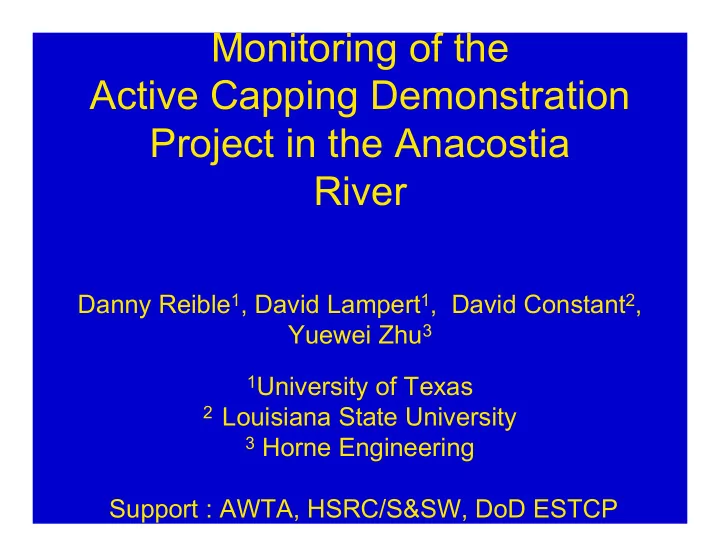

Monitoring of the Active Capping Demonstration Project in the Anacostia River Danny Reible 1 , David Lampert 1 , David Constant 2 , Yuewei Zhu 3 1 University of Texas 2 Louisiana State University 3 Horne Engineering Support : AWTA, HSRC/S&SW, DoD ESTCP
Anacostia River Site Aerial Photograph Demonstration Area
Anacostia River Site • Contaminant Loadings Contaminant Loading Phenanthrene 1000-4000 μ g/kg Chrysene 800-3500 μ g/kg Benzo[a]pyrene 1000-4500 μ g/kg Zn 1000 mg/kg Cr 80 mg/kg Cu 280 mg/kg Pb 500 mg/kg Cd 4 mg/kg
Anacostia River Site • Project Objective – To demonstrate on a field scale the ability to design and construct caps that combine containment and treatment of contaminated sediments
Capping Materials • AquaBlok – A bentonite material that forms a low-permeability barrier between the contaminated sediment and the overlying aquatic ecosystem. • Apatite – Mineral that sorbs metals through a surface precipitation reaction • Coke Breeze – By-product of coal refining process that strongly sorbs organic compounds • Sand
Anacostia River Site
Evaluation Approach • Measure – Cap sediment concentrations – Pore water concentrations – Accumulation in benthic organisms (lab) • Model migration through caps – Pore water flow rates – Adsorption parameters – Degradation (if any?) • Compare effectiveness of different cap materials
Coke - Core 1 Total PAHs vs Depth October 2005 Total PAHs Concentration (ug/kg) 0 2000 4000 6000 8000 10000 12000 14000 16000 0 S - Sand Layer 1 CB-C1-S-02 SD - Sediment Layer Depth Below Cap-Water Interface (inches) Month 18 Monitoring Event 2 3 CB-C1-S-04 4 Sand 5 CB-C1-S-06 6 Coke Breeze Mat 7 Native Sediment 8 CB-C1-SD-04-D 9 10 11 CB-C1-SD-04 12
18-Month Coring Results – Apatite Cap Apatite Cap PAH Concentration Profile 34.5 35.0 Phenanthrene 35.5 Pyrene Depth (cm) 36.0 Benzo[a]anthracene 36.5 Apatite-Sediment Interface Chrysene 37.0 Benzo[b]fluoranthene 37.5 Benzo[k]fluoranthene 38.0 38.5 Benzo[a]pyrene 39.0 0 1000 2000 3000 4000 5000 6000 PAH Concentration ( μ g/kg)
18-Month Coring Results – Apatite Cap Percent Passing and C/C0 Versus Depth 34.5 35.0 Phenanthrene Pyrene 35.5 Benzo[a]anthracene 36.0 Chrysene Depth (cm) Benzo[b]fluoranthene Apatite-Sediment Interface 36.5 Benzo[k]fluoranthene Apatite-Sediment Interface 37.0 Benzo[a]pyrene % Passing 37.5 38.0 38.5 39.0 0% 20% 40% 60% 80% 100% %
Better Indicator of Migration? • Pore Water Concentrations – Peepers • Place core with 3 mL sample ports every 1 cm into caps, then remove and analyze for metals/PAHs – Solid-Phase Membrane Extraction (SPME) • Study aqueous-phase concentrations (not bound to colloids) • Potential to determine concentrations at lower levels (ppt)
Peepers Sampling
Peepers Sampling
Solid Phase MicroExtraction Sorbent Polymer • PDMS (poly-dimethylsiloxane) – Thickness of glass core: 114-108 µ m – Thickness of PDMS coating: 30-31 µ m – Volume of coating: 13.55 (±0.02) µ L PDMS per meter of fibre x
Slotted tube for SPME
SPME Measured Porewater Profile 600 500 Pore water Concentration Surface mean Concentration ng/L 400 300 Surface mean 200 100 0 0 5 10 15 20 25 30 Depth cm
Measured and estimated pore-water concentrations of PAHs (ng/L) PAH Measured Measured Theoretical* SPME by LLE Phenanthrene 210 370 1810 pyrene 610 730 990 chrysene 7.1 7.8 83 B[ b ]F 2.1 5.3 70 B[ k ]F 1.8 2 55 B[ a ]P 1.9 2 68 * Estimated from log K oc= log K ow-0.21 (reversibly sorbed with K SW ~ K oc f oc ) Predicted BSAF ~ Ratio of measured to theoretical concentration Assumes K lipid ~ K oc
Measured and estimated pore-water concentrations of PCBs (ng/L) PCB Measured Theoretical* #28 1.9 2.5 #52 2.0 2.0 #153 0.4 0.77 #138 0.45 0.60 #180 0.38 0.16 * Estimated from Log K oc= 1.03* log K ow-0.61
Biota-sediment accumulation factors of PAHs and PCBs(Measured vs predicted) 0.3 3 0.25 2.5 0.2 2 Measured BSAF Measured BSAF 0.15 1.5 1 0.1 PCBs 0.05 PAHs 0.5 0 0 0 0.5 1 1.5 2 2.5 3 0 0.05 0.1 0.15 0.2 0.25 0.3 Predicted BSAF Predicted BSAF
Lessons being Learned • Innovative cap materials possible to place using conventional equipment with experienced contractor • Possible to apply thin (6”) layer of cap material using clamshell techniques • A laminated mat provides opportunities for controlled placement of light and/or high value materials (e.g. μ scale zero valent iron or activated carbon) • AquaBlok effectively diverted groundwater flow • Gas accumulated under AquaBlok but was released rapidly and irregularly with no observable negative consequences • Contaminant profiles consistent with sediment-cap/sand intermixing – no observed migration • Pore water assessments may provide more information
Recommend
More recommend